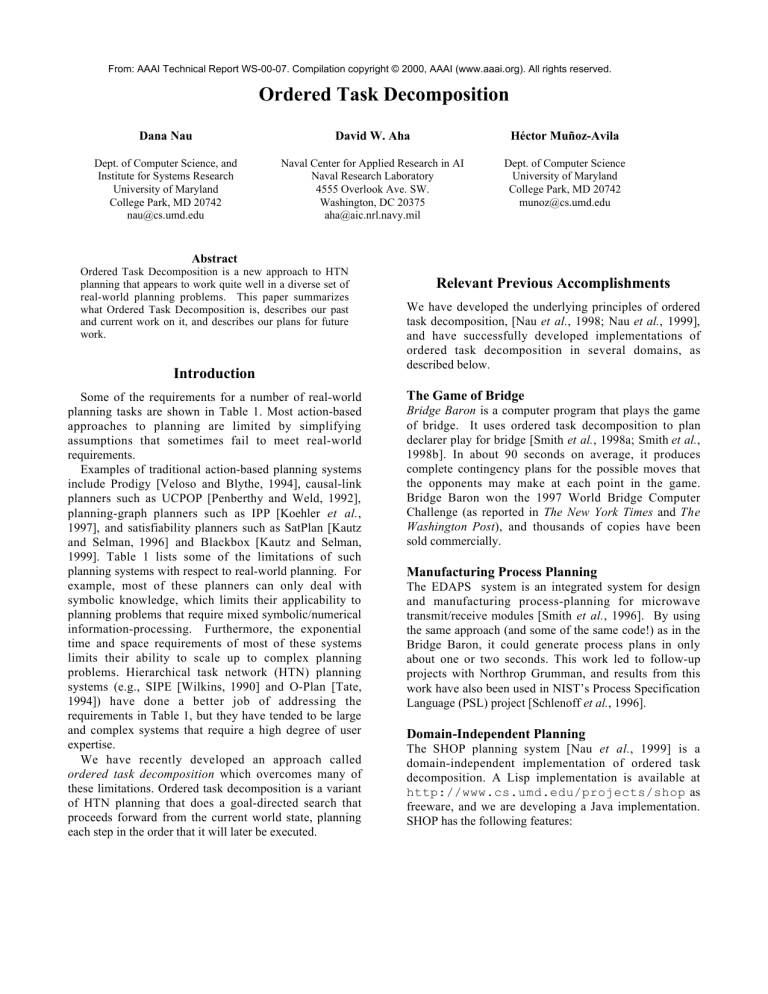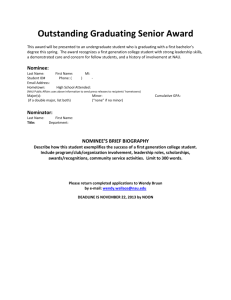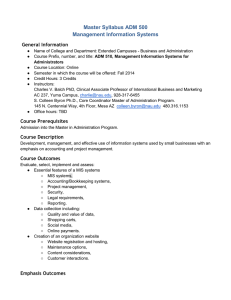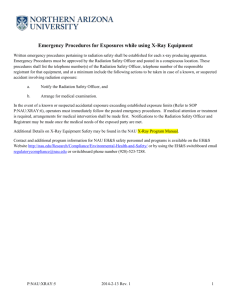Ordered Task Decomposition Dana Nau David W. Aha Héctor Muñoz-Avila

From: AAAI Technical Report W S00 07 . Compilation copyright © 2000 , AAAI (www.aaai.org). All rights reserved.
Ordered Task Decomposition
Dana Nau
Dept. of Computer Science, and
Institute for Systems Research
University of Maryland
College Park, MD 20742 nau@cs.umd.edu
David W. Aha
Naval Center for Applied Research in AI
Naval Research Laboratory
4555 Overlook Ave. SW.
Washington, DC 20375 aha@aic.nrl.navy.mil
Héctor Muñoz-Avila
Dept. of Computer Science
University of Maryland
College Park, MD 20742 munoz@cs.umd.edu
Abstract
Ordered Task Decomposition is a new approach to HTN planning that appears to work quite well in a diverse set of real-world planning problems. This paper summarizes what Ordered Task Decomposition is, describes our past and current work on it, and describes our plans for future work.
Introduction
Some of the requirements for a number of real-world planning tasks are shown in Table 1. Most action-based approaches to planning are limited by simplifying assumptions that sometimes fail to meet real-world requirements.
Examples of traditional action-based planning systems include Prodigy [Veloso and Blythe, 1994], causal-link planners such as UCPOP [Penberthy and Weld, 1992], planning-graph planners such as IPP [Koehler et al.,
1997], and satisfiability planners such as SatPlan [Kautz and Selman, 1996] and Blackbox [Kautz and Selman,
1999]. Table 1 lists some of the limitations of such planning systems with respect to real-world planning. For example, most of these planners can only deal with symbolic knowledge, which limits their applicability to planning problems that require mixed symbolic/numerical information-processing. Furthermore, the exponential time and space requirements of most of these systems limits their ability to scale up to complex planning problems. Hierarchical task network (HTN) planning systems (e.g., SIPE [Wilkins, 1990] and O-Plan [Tate,
1994]) have done a better job of addressing the requirements in Table 1, but they have tended to be large and complex systems that require a high degree of user expertise.
We have recently developed an approach called
ordered task decomposition which overcomes many of these limitations. Ordered task decomposition is a variant of HTN planning that does a goal-directed search that proceeds forward from the current world state, planning each step in the order that it will later be executed.
Relevant Previous Accomplishments
We have developed the underlying principles of ordered task decomposition, [Nau et al., 1998; Nau et al., 1999], and have successfully developed implementations of ordered task decomposition in several domains, as described below.
The Game of Bridge
Bridge Baron is a computer program that plays the game of bridge. It uses ordered task decomposition to plan declarer play for bridge [Smith et al., 1998a; Smith et al.,
1998b]. In about 90 seconds on average, it produces complete contingency plans for the possible moves that the opponents may make at each point in the game.
Bridge Baron won the 1997 World Bridge Computer
Challenge (as reported in The New York Times and The
Washington Post), and thousands of copies have been sold commercially.
Manufacturing Process Planning
The EDAPS system is an integrated system for design and manufacturing process-planning for microwave transmit/receive modules [Smith et al., 1996]. By using the same approach (and some of the same code!) as in the
Bridge Baron, it could generate process plans in only about one or two seconds. This work led to follow-up projects with Northrop Grumman, and results from this work have also been used in NIST’s Process Specification
Language (PSL) project [Schlenoff et al., 1996].
Domain-Independent Planning
The SHOP planning system [Nau et al., 1999] is a domain-independent implementation of ordered task decomposition. A Lisp implementation is available at http://www.cs.umd.edu/projects/shop as freeware, and we are developing a Java implementation.
SHOP has the following features:
Table 1: Typical restrictions of traditional approaches to planning, compared with the capabilities often needed for real-world planning.
Unstack(x,y)
Pre: on(x,y),
clear(x), handempty
Delete: on(x,y),
clear(x), handempty
Add: holding(x),
clear(y)
Capability Traditional restrictions
Scalability to large problems
Scalability limited by exponential space/time requirements
Embeddability large monolithic systems
Expressivity Purely symbolic computations on logical atoms
Contingency planning
Perfect information; no contingencies occur
Multi-agent planning
Incremental retrieval
Decision rationale
Knowledge acquisition
The planner is the only agent capable of causing any change in the world
Plans generated from scratch; adaptation of previous plans not supported
Reasoning only needs to be intelligible to researchers
Done manually
What is needed
Fast enough to respond to users in real time on complex problems lightweight, embedded plan-inferencing tools
Mixed symbolic & numeric computations on arbitrary data structures
Imperfect information; need anytime access to contingency plans
Need to model actions of other agents (both hostile and friendly)
Fast template retrieval and elaboration; incorporation of doctrine and prior experience
Reasoning that is intelligible to users
Reduce user effort for acquisition and maintenance
Our approach
Ordered task decomposition
Implementation as embedded planner
Representational capabilities of ordered task decomposition
Explicit parameterizable contingency plans using game trees
Represent external agents’ actions explicitly
Hierarchical template memory, multiple indexing, retrieval by partial matching
Storage and explanation of decision rationale
Semi-automated acquisition and maintenance
Our implementations
Bridge Baron and EDAPS
[Nau et al, 1998]; SHOP [Nau
et al., 1999]
Bridge Baron and EDAPS
[Nau et al, 1998]; HICAP
[Munoz et al., 1999a, 1999b]
Bridge Baron and EDAPS
[Nau et al, 1998]; SHOP [Nau
et al., 1999]
Bridge Baron [Nau et al,
1998]
Bridge Baron [Nau et al,
1998]
HICAP [Munoz et al., 1999a,
1999b]
(none yet)
(none yet)
•
Simplicity: the basic planning algorithm is only sixteen lines long, and the entire Lisp implementation is less than 1000 lines;
•
High representational power: SHOP combines HTN decomposition, Horn-clause inference, and the ability to do numeric computations;
•
Computational efficiency: in our tests on some standard benchmark problems, SHOP ran several orders of magnitude faster than other domainindependent planning systems.
Military Operations Planning
In an ongoing collaboration on interactive plan authoring, we have embedded SHOP as the automated planning module in the HICAP system for authoring of
Noncombatant Evacuation Operation (NEO) plans
[Munoz-Avila et al., 1999a; Munoz-Avila et al., 1999b].
The basic structure of HICAP is shown in Figure 1.
HICAP dynamically elaborates plans, derived from military doctrine on NEOs and represented as HTNs
(hierarchical task networks), via interactive case-base
U
S
E
R
Plan
Scenario
IDS
Requests Elicited plan
HICAP
Lessons
Deliverer
Hierarchical
Task Editor
(HTE)
NaCoDAE/HTN
CCBR Tool
JSHOP
Generative
Planner
DecTS
Decision
Tracker
Figure 1. Architecture of the HICAP system for authoring of Noncombatant Evacuation Operation (NEO) plans.
inferencing [Aha and Breslow, 1997; Breslow and Aha,
1997]. HICAP assists users with dynamical plan elaboration by providing the following functionality:
• manual editing of plans represented using HTNs using a hierarchical task editor;
• interactive plan expansion using a case-based reasoning module called NaCoDAE [Aha and Breslow, 1997];
• automated plan expansion using JSHOP, our new Java implementation of the SHOP planning system;
• a lessons delivery module that, by monitoring HICAP's plan, can notify the user when lessons become applicable, and recommend corresponding plan elaboration operations [Weber et al., 2000].
We are currently extending HICAP’s capabilities as part of DARPA’s Active Templates program [Dyer, 1999].
Discussion
We believe that the following are the primary advantages of our ordered-task-decomposition approach:
•
A fast, simple, embeddable planning algorithm. In contrast to most AI planning systems (which search backwards from the goal to reduce the amount of backtracking), backward search is unnecessary in ordered task decomposition, because the goal-directed focus can be maintained using the HTN decomposition itself [Nau et al., 1998]. This produces a significant
speed gain; for example, [Nau et al., 1999] describes orders-of-magnitude speed gains versus “fast” AI planners. As described earlier, this approach has been successfully used to build several high-performance embedded systems that are small and easy to use.
•
Expressivity. At each step in generating a plan using ordered task decomposition, the planning algorithm has already planned for all preceding steps, so it can compute the current step’s complete input state. Thus, it is not restricted to traditional plan representation techniques (where states and operator preconditions and effects are represented as sets of logical atoms, and are evaluated via unification), but can use arbitrary computer code to represent states, preconditions, and effects. This provides more expressive state and
operator representations. For example, our implementations of ordered task decomposition
(described earlier) perform mixed symbolic/numeric computation and inferencing, incorporate mixedinitiative interaction, perform “what if?” analysis and contingency planning, and incorporate case retrieval and modification.
•
The ability to do contingency planning. In our application of ordered task decomposition to the game of bridge (described earlier), we used ordered task decomposition to generate and evaluate game trees that represent various contingencies that may arise in an imperfect-information game. We integrated this with a user interface for mixed-initiative interaction with users and external data input. The basic idea is to generate and retain alternative plan branches for likely violations to a plan’s conditions (i.e., so that they can be quickly retrieved and executed), and to dynamically generate plans corresponding to unlikely contingencies.
•
Incremental retrieval techniques. Incremental retrieval techniques have recently been developed in
the conversational case-based reasoning (CCBR) literature [Aha and Breslow, 1997; Munoz-Avila et al.,
1999a; Munoz-Avila et al., 1999b] for data structures that are similar HTNs. We have adapted these techniques in order to incorporate JSHOP, the new Java version of our SHOP generative planner.
The primary limitations of our current work are as follows.
•
Although we have implemented the abilities for contingency planning and for reasoning about external agents, we have only done so in a specific problem domain (the game of bridge). We still need to develop a domain-independent generalization and formalization of these techniques.
•
Our proposed approaches for incorporating decision rationale and doing knowledge acquisition (see Table
1) have not yet been implemented.
•
More work needs to be done to optimize the speed of
SHOP’s data structures, and to make it easier to debug domain descriptions in SHOP. As an example, we recently found that by making a simple modification to how SHOP represents its current state of the world, we could speed up SHOP by about an order of magnitude on large problems.
We intend to address the above problems in our future work, in order to extend the capabilities of SHOP and
HICAP.
Acknowledgements
This work has been supported in part by the following grants and contracts: ARL DAAL01-97-K0135, NRL
N00173981G007, AFRL F306029910013, NSF DMI-
9713718, and AFRL F30602-00-2-0505.
Bibliography
D. W. Aha and L. A. Breslow. Refining conversational case libraries. In Proceedings of the Second International
Conference in Case-Based ReasoningProvidence, RI,
1997. Springer-Verlag.
L. A. Breslow and D. W. Aha. "NACODAE: Navy
Conversational Decision Aids Environment." Tech.
Report AIC-97-018, Naval Research Laboratory, Navy
Center for Applied Research in Artificial Intelligence,
Washington, DC, 1997.
D. Dyer. "Active Templates: Dynamic Spreadsheets for
Planning and Execution." Tech. Report, DARPA
Information Systems Office, June, 1999.
H. Kautz and B. Selman. Pushing the envelope: Planning, propositional logic, and stochastic search. In Proceedings of the 13th National Conference of the American
Association for Artificial Intelligence, pages 1194-1201,
1996.
H. Kautz and B. Selman. "Unifying SAT-based and
Graph-based Planning". In Proc. IJCAI-99, Stockholm,
1999.
J. Koehler, B. Nebel, J. Hoffman and Y. Dimopoulus.
Extending planning graphs to an ADL subset. In Proc.
ECP-97, Toulouse, France, 1997.
H. Munoz-Avila, D. Aha, L. Breslow and D. Nau.
HICAP: an interactive case-based planning architecture and its application to noncombatant evacuation operations. In IAAI-99, pages 870-875, 1999a.
H. Munoz-Avila, D. McFarlane, D. Aha, J. Ballas, L.
Breslow and D. Nau. Using guidelines to constrain interactive case-based HTN planning. In Proceedings of the Third International Conference on Case-Based
Reasoning (ICCBR-99), 1999b. Finalist for the best paper award.
D. Nau, Y. Cao, A. Lotem and H. Munoz-Avila. SHOP:
Simple Hierarchical Ordered Planner. In IJCAI-99, pages
968-973, 1999.
D. S. Nau, S. J. J. Smith and K. Erol. Control Strategies in
HTN Planning: Theory versus Practice. In AAAI-98/IAAI-
98 Proceedings, pages 1127-1133, 1998.
J. S. Penberthy and D. Weld. UCPOP: A Sound,
Complete, Partial Order Planner for ADL. In Proc. KR-
92, 1992.
C. Schlenoff, A. Knutilla and S. Ray. "Unified process specification language: Requirements for modeling process." Tech. Report , National Institute of Standards and Technology, Gaithersburg, MD 20899, September,
1996.
S. J. Smith, K. Hebbar, D. Nau and I. Minis. Integrating
Electrical and Mechanical Design and Process Planning.
In Proc. Second IFIP Workshop on Knowledge-Intensive
CAD, September, 1996.
S. J. J. Smith, D. S. Nau and T. Throop. "Computer
Bridge: A Big Win for AI Planning." AI Magazine,
19(2):93-105, June, 1998a.
S. J. J. Smith, D. S. Nau and T. Throop. Success in
Spades: Using AI Planning Techniques to Win the World
Championship of Computer Bridge. In AAAI-98/IAAI-98
Proceedings, pages 1079-1086, 1998b.
A. Tate. Mixed Initiative Planning in O-Plan2. In
Proceedings of the ARPA/Rome Laboratory Knowledge-
Based Planing and Scheduling Initiative, pages 512-516.
Tuscon, AR, 1994. Morgan Kaufmann.
M. Veloso and J. Blythe. Linkability: Examining causal
link commitments in partial-order planning. In AIPS-94,
1994.
R. Weber, D. W. Aha, L. K. Branting, J. R. Lucas and I.
Becerra-Fernandez. Active case-based reasoning for lessons delivery systems. In Proceedings of the Thirteenth
International Conference of the Florida Artificial
Intelligence Research Society, Orlando, FL, 2000. AAAI
Press. To appear.
D. Wilkins. "Can AI Planners Solve Practical Problems?"
Computational Intelligence, 6(4):232-246, 1990.




